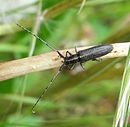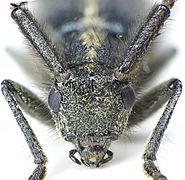White-striped thistle buck
| White-striped thistle buck | ||||||||||||
|---|---|---|---|---|---|---|---|---|---|---|---|---|

White-striped thistle buck |
||||||||||||
| Systematics | ||||||||||||
|
||||||||||||
| Scientific name | ||||||||||||
| Agapanthia cardui | ||||||||||||
| ( Linnaeus , 1767) |
The Weißstreifige Thistle Bock ( Agapanthia cardui , Syn. : Agapanthia pannonica ) is a beetle from the family of the longhorn beetle and the subfamily Lamiinae . To distinguish it from larger related species, it is also called the small thistle buck . The species is found in Central Europe only in particularly warm places. It is listed in the Red List of Endangered Species in Germany , as well as in Bavaria , North Rhine-Westphalia and Thuringia under category 2 (endangered). In Rhineland-Palatinate , the species is classified as endangered.
Comments on the name and the system
The species was first listed by Linnés in 1767 in the genus Cerambyx under number 56 as Cerambyx cardui . After the short description, Linné continues: habitat in Carduis Europae australioris ( lat. Lives on thistles in southern Europe), which explains the species name cardui and the name "thistle buck". The species was later placed in the genus Agapanthia (from ancient Greek αγαπάω agapáo, I love and άνθος ánthos, flower). This genus is represented worldwide with nine subgenera, in Europe with 22 species. The part of the name "Weißstreifig" refers to a stripe with white hair along the wing cover seam.
Characteristics of the beetle
The beetle reaches a body length of seven to 13 millimeters. The body is roughly cylindrical, dark to black and slightly shiny metallic. It is mostly loosely long, black-haired and covered in strips with very short white to whitish-yellow hair ( toment ) (Fig. 5).
The head is inclined downwards perpendicular to the body axis. The mouthparts point downwards, the last link of the jaw probe is spindle-shaped and pointed and not truncated at an angle (Fig. 4). As in the majority of longhorn beetles, the antennae are thin and long, in both sexes they protrude beyond the posterior end of the elytra. In contrast to the majority of longhorn beetles, the antennae are not eleven, but twelve. The first antenna segment is long and club-shaped, and without a crescent-shaped flattening at the end (Fig. 4). As with most longhorn beetles, the second antennae is very short. The underside of the following antenna segments are covered with long eyelash hairs (clearly visible in Fig. 1 when enlarged). In addition, from the third link onwards, the ends of the antennae are dark and the base lighter, so that the antennae appear more or less clearly curled. Outwardly, the antennae become increasingly narrow and shorter. The kidney-shaped compound eyes encircle the antenna base from behind (in Fig. 5 the inner edge can still be seen above the antennae behind them).
The pronotum is a little longer than it is wide and has long hair. At the front edge it is as wide as the rear edge of the head, at the back it is hardly wider and at the rear edge it is significantly narrower than the elytra. The loose central stripe of white to ocher yellow tomentose continues on the head and abdomen. On each side of the pronotum there is a longitudinal stripe of the same color, sometimes indistinct, which is only visible from the side (taxo picture and Fig. 2).
The elytra are very dark and have a slight lead sheen or a greenish metallic sheen. They taper towards the back, but this is not necessarily visible from above. Each wing cover ends more or less pointedly. The wing cover seam and the label appear white because of the tomentation. This fact owes the species the name part "white stripes".
The legs are pretty short. The five-limbed tarsi appear four-limbed (pseudotetrameric), since the fourth limb is very small and hidden between the lobes of the third limb.
 Fig. 1: top Fig. 2: side view Fig. 3: bottom   |
 Fig. 4: Head Fig. 5: Detail of the wing cover  |
biology
The warmth-loving species occurs in Central Europe only in dry hot spots, for example in vineyards and quarries or on semi-arid grasslands. The adults are mainly found on thistles, but also on a variety of other flowers.
The larva develops in a variety of herbaceous plants, particularly ring thistles and thistles . It takes a year to develop. The adult beetle appears in late spring. It is often found on thistles.
distribution
The species is not only common in large parts of Europe, but its range extends from Spain to around the Black Sea and into Iran . Finds from North Africa are also known. In the north, the beetle is absent in Great Britain , the Netherlands , Denmark , Sweden , Norway and Finland , as well as the countries of the Baltic States .
literature
- Heinz joy, Karl Wilhelm Harde, Gustav Adolf Lohse (ed.): The beetles of Central Europe . tape 9 . Cerambycidae Chrysomelidae . Spektrum Akademischer Verlag, Munich 1999, ISBN 3-8274-0683-8 (first edition: Goecke & Evers, Krefeld 1966).
- Adolf Horion: Faunistics of the Central European Beetles, Bd. XII . Überlingen-Bodensee 1974
- Klaus Koch : The Beetles of Central Europe . Ed .: Heinz Freude . tape 3 : ecology . Goecke & Evers, Krefeld 1992, ISBN 3-87263-042-3 .
Individual evidence
- ↑ Red lists at Science4you
- ^ C. Linnaeus: Systema naturæ, Tom. I. Pars II. Editio duodecima reformata first description p.632 no.56
- ↑ Sigmund Schenkling: Explanation of the scientific beetle names (genus)
- ↑ Agapanthia at BioLib
- ↑ Agapanthia at Fauna Europaea. Retrieved February 18, 2013
- ↑ Agapanthia cardui in Fauna Europaea. Retrieved December 15, 2010